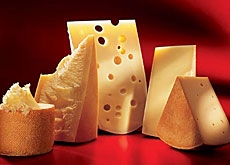
swiss cheese looks to expand its empire

Switzerland boasts 450 different types of cheese, with Emmental, Gruyère and Sbrinz and Appenzell being the best-known products.
Only a third of annual cheese production is for export, but this is likely to change amid further steps to remove trade barriers with the European Union.
There is some truth to the idea that cheese, like chocolate, is one of Switzerland’s staple foods. It comes with or without holes, in soft or hard varieties, as industrial product or as an exclusive hand-made delicacy from an alpine farm.
“Switzerland is one of the few countries in the world with a cheese-making tradition going back several centuries,” says David Escher, director of Switzerland Cheese Marketing.
“Even today a great deal of our cheeses are produced according to ancient recipes and with old techniques,” he told swissinfo.
“The various cheeses have their origins in the different regions of the country and they are part of
our culture.”
The Swiss show their fondness of cheese by consuming an average of 20 kilograms per person every year.
“Swiss cheeses make up about 80 per cent of the total cheese consumption in Switzerland,” said Escher.
Exports
Only 34 per cent of the 167,706 tons of cheese produced in the country was exported in 2005.
This seemingly modest figure has to be seen in the context of Switzerland’s agricultural sector, which is struggling to survive in an increasingly globalised market and which is protected from competition
by high trade barriers.
The cheese export percentage is clearly lower than other typical Swiss products. In all, 95 per cent of Swiss watches are exported, the machinery sector sells 88 per cent of its output abroad and the Swiss chocolate industry makes 57 per cent of its earnings on the global market.
“There are primarily historical reasons for the difference. About 100 years ago too much cheese and butter were exported and there was not enough left for consumers in Switzerland,” said Escher.
As a result, measures were introduced to ensure that the domestic market was given priority. Over the years the export
restrictions have been eased but have not disappeared completely.
Today there are purely economic reasons for maintaining the trade barriers as there is a glut of different products on the market.
“Swiss cheese products cost twice as much as in shops abroad compared with other local cheeses,” added Escher.
More foreign sales
Despite the higher prices, Swiss dairy exports are on the increase, while imports have dropped slightly.
In 2004 exports recorded a 7.3 per cent increase and figures for 2005 show a further 5.5 per cent hike mainly due to the EU and the United
States – the two main foreign markets. When the bilateral agreement on processed agricultural products between Switzerland and the EU takes effect next year, the cheese trade will be given another boost, experts say.
“Today 80 per cent of the trade in cheese with the EU is already liberalised which shows that the Swiss cheese sector has adapted well,” Escher said.
The abolition of customs duties could offer Swiss cheese producers new opportunities as Swiss consumers continue to prefer local diary products and leave imported goods on the shelves.
At the same time, Swiss cheese enjoys an excellent reputation
among gourmets in other countries – a situation that looks promising for the future.
“The cheese sector has gone through some important reforms over the past few years. As a result we have become stronger and more competitive,” said Escher.
swissinfo, Marzio Pescia
The origins of cheese making are not known, but it is unlikely to be a Swiss invention.
The first historic reference to cheese is about 3,500 years old and it is mentioned in the Old Testament.
The ancient Roman historian, Pliny the Elder, wrote in the first century about a cheese-making tribe living in a region that is now Switzerland.
The most popular cheese varieties in Switzerland are Mozzarella, Gruyère and Raclette.
The prime cheese export is Emmental, nearly 80% of it goes abroad.
The export markets are Italy, Germany, the US and France.

In compliance with the JTI standards
More: SWI swissinfo.ch certified by the Journalism Trust Initiative




































You can find an overview of ongoing debates with our journalists here . Please join us!
If you want to start a conversation about a topic raised in this article or want to report factual errors, email us at english@swissinfo.ch.